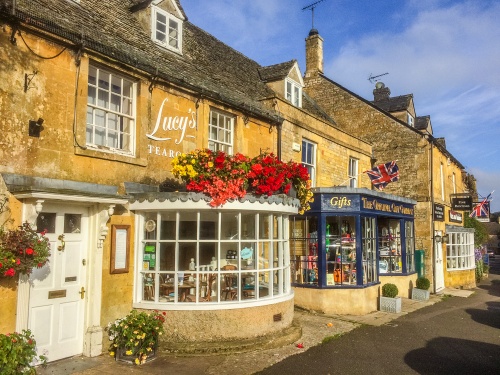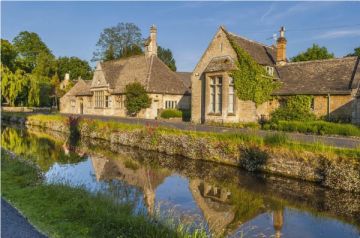
"Stow on the Wold, where the wind blows cold"
So runs an old rhyme describing this historic Cotswold market town. Stow on the Wold is the highest town in the Cotswolds at 790 feet above sea level, which accounts for the somewhat unflattering rhyme, though, to be honest, I've never found it to be windier or colder than anyplace else in the region.
Stow is well placed at the junction of eight roads, one of them the Roman Fosse Way. One of the first things you notice on entering Stow - aside from relief at finally getting off the busy A429 - is the remarkably large market square. The size of the square is a reminder of Stow's heritage as the site of a major sheep market. Daniel Defoe recorded that 20,000 sheep were sold during a single day.

There has been a market here since 1107 when Henry II granted a charter and changed the name of the town from Edwardstow. But the age of the market square pales in relation to the age of the Royalist Hotel, on Digbeth Street; it is reputedly the oldest inn in England and claims a history reaching as far back as 987AD.
In the dining lounge is a medieval fireplace showing "witch's marks"; signs meant to ward off spells. There is also a resident ghost or two, and rumours of a secret tunnel from the cellars, leading under the street.
The Royalist is not the only historic inn in Stow. The Kings Arms, on the market square, hosted King Charles I before the Battle of Naseby. More recently, it featured in the television production of Thomas Hardy's Mayor of Casterbridge.

If the size of the market square is the first thing you notice, the number of antique shops must be the second! Stow is one of the major centres for antique shopping in southern England. Though there are undoubted bargains available if you know what you are looking for, most of the shops cater to a ... shall we say... well-heeled clientele.
The alleys leading from the market square were intentionally built narrow and winding, as a way to control sheep.
The lovely church of St Edward repays a visit many times over. The church is primarily a product of the 11th century, though the tower was remodelled in the 15th century. Quite apart from the lovely architecture, the church bears visiting for its historical connection with the Battle of Stow on the Wold, the final conflict of the English Civil War.
In 1646 a Royalist army under Astley marched through the region in a desperate attempt to join up with King Charles at Oxford. They were brought to bay at Stow by a Parliamentary force. The fighting was fierce and deadly; the Royalists were routed, and over 1000 imprisoned within the church.
So great was the slaughter that it was said that ducks were able to bathe in the pools of blood that formed on the street leading away from the market square. This is said to be the origin of the street's name; "Digbeth", for "Duck's Bath".

Though the tale of the origins of Digbeth Street may be apocryphal, it is sobering to think that where antique shoppers now jostle with baby carriages, men once fought and died.
There is more to St Edward's than this memory of conflict; take the time to walk around the outside of the church to the north side. There a small door peers between two massive old tree trunks. You almost expect a gnome to peek around the door at any minute.
Fancy aside, the church is quite enjoyable. The tower rises to 88 feet and boasts the heaviest peal of bells in all of Gloucestershire. In the south aisle is a large painting of the Crucifixion by Gaspar de Craeyer (1582-1669).
St Edwards Hall, in the market square, is a much later addition to the architectural landscape of Stow, being built in 1878. The money for the building came from funds left unclaimed in the town Savings Bank. The Hall houses the public library and exhibitions of Civil War artefacts.
About Stow on the Wold
Address: Stow on the Wold,
Cotswolds,
Gloucestershire,
England
Attraction Type: Town
Location map
OS: SP190 256
Photo Credit: David Ross and Britain Express
HERITAGE
 We've 'tagged' this attraction information to help you find related historic attractions and learn more about major time periods mentioned.
We've 'tagged' this attraction information to help you find related historic attractions and learn more about major time periods mentioned.
Historic Time Periods:
Find other attractions tagged with:
Medieval (Time Period) -
NEARBY HISTORIC ATTRACTIONS
Heritage Rated from 1- 5 (low to exceptional) on historic interest
Stow-on-the-Wold, St Edward's Church - 0.1 miles (Historic Church) ![]()
Longborough, St James - 2.6 miles (Historic Church) ![]()
Upper Slaughter Manor - 2.7 miles (Historic House) ![]()
Upper Slaughter, St Peter's Church - 2.7 miles (Historic Church) ![]()
Lower Oddington, St Nicholas Church - 2.8 miles (Historic Church) ![]()
Adlestrop, St Mary Magdalene - 3.1 miles (Historic Church) ![]()
Salmonsbury Camp - 3.1 miles (Prehistoric Site) ![]()
Little Rissington, St Peter's Church - 3.5 miles (Historic Church) ![]()
Nearest Holiday Cottages to Stow on the Wold:
Stow-on-the-Wold, Gloucestershire
Sleeps: 4
Stay from: £483.00 - 1855.00
Stow-on-the-Wold, Gloucestershire
Sleeps: 6
Stay from: £918.00 - 4126.00
Stow-on-the-Wold, Gloucestershire
Sleeps: 4
Stay from: £682.00 - 3816.00
More self catering near Stow on the Wold










